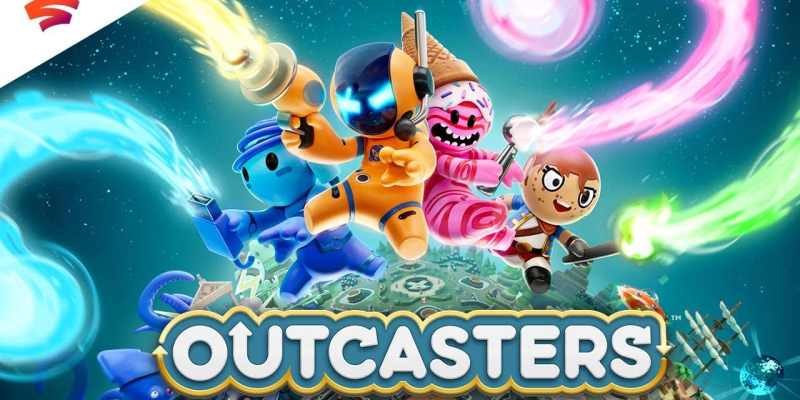Google Stadia has received plenty of criticism since it debuted a year ago from players who sometimes couldn’t see the point of an all-streaming platform with few games and no subscription library. However, Google has addressed some of the criticism in the past year and is slowly publishing its own exclusives under Stadia Games and Entertainment. And while Outcasters may not be Stadia’s killer app, it does nicely complement the platform.
Outcasters is a top-down twin-stick multiplayer shooter from Splash Damage (Gears Tactics, Dirty Bomb) that pits teams or individual players against others in reactive, labyrinthine maps. At launch there are just three modes in the game, each of which will be familiar to anyone who’s played shooters online before. One is like Team Deathmatch, another is a coin-banking mode, and the last is like very small battle royale, where the map slowly closes in on just a handful of players.
It’s quickly apparent that this isn’t enough, as these modes are fun in rotation, but they need a few more. On top of that, you can’t choose which game mode you play in a live setting, and there is no way to play the CPU, which makes you totally dependent on playing with others. That means it’s sometimes hard to even find a game if it’s a weird hour on a burgeoning platform like Stadia.
The allure of Outcasters comes mainly from its unique bullet-curving mechanic. As each top-down level is full of zig-zagging hallways, shifting obstacles, and contraptions that can alter how players move about, like unlockable doors and teleporters, this isn’t just a point-and-shoot multiplayer experience. The skill ceiling is higher than you might think for a game that looks so silly at first glance, and the skill floor may actually deter some players from participating.
https://www.youtube.com/watch?v=l0KWWbwT_6o
Especially early on, it’s easy to miss shot after shot, and if you want to run and gun head-on, you’ll soon find yourself eliminated. The curvature of ammo is not a gimmick; it’s the foundation of Outcasters‘ design. It works very well and thus keeps Outcasters afloat despite other issues.
After firing, you have a brief moment where you can control the direction of your projectiles. This makes it critical that you play the map wisely and keep yourself out of harm’s way. You won’t always have a view of who is near thanks to the isometric camera angle. Likewise, you’ll rarely have an easy shot to make, so maneuvering is an exciting part of the game’s strategy, especially in the last-player-standing mode when the map is closing in and traps are going off around the dwindling space. These foundational gameplay elements clearly support the ability for Outcasters to grow and expand into something lasting, but more modes and gameplay options such as custom games are needed to ensure it achieves its full potential.
Fortunately, Splash Damage does seem to have long-term plans for Outcasters. Characters are customizable, eschewing the once ubiquitous grit and grime of anti-hero leads in favor of silly, colorful avatars who can sport a range of different googly eyes, costumes, and other patterns. This design trend is often conducive to longevity, as your game can’t grow to look old so fast when it was never going for photorealism in the first place.

I tend to love colorful games such as Fall Guys and Sea of Thieves, and though Outcasters can be just as vibrant and lighthearted as those, it’s the character models themselves that leave one wanting. As the game’s progression system is largely built around unlocking new style options, they need to be more desirable. The variants in faces are akin to half-hearted doodlings on a notebook, and while hair and clothing go a bit deeper, they still lack a lot at launch. Additionally, many of those that are there are only available as paid DLC. Few can be earned with the in-game currency today.
Launch cosmetics for a game with heavy cosmetic intentions can often be lacking, but in Outcasters the character design makes it feel like they may never be that great, even in the long run. There’s just something very simplistic about them, and when you consider the in-game currency only unlocks random parts of the character you may want to complete, it can feel like a slog for little reward.
Despite lacking a full body of features, Outcasters‘ quick rounds entertain and introduce a unique mechanic. With that promise, Outcasters is less about proving the viability of game streaming and more about just showing off a cool game. Nonetheless, all my time with the game has been lag-free and hit detection has seemed totally fair and reliable, which is both crucial for a competitive multiplayer game like Outcasters and a good sign for Stadia’s general longevity.
Ultimately, Outcasters mostly seems ready to settle into its niche that it’s created. It’s not designed to be the killer app that reels in a mass of new players, but it should attract some. Better yet, since it launched directly into Stadia Pro, it’s there on day one for the folks who are already the most committed. For a platform trying to find its footing in a crowded, competitive space, solidifying the publisher-player relationship is crucial. There will be bigger, flashier, and likely better games to come from Stadia Games and Entertainment in the years ahead, but for now, those already playing via Google’s tangerine-tinted cloud will find they have their first example of a fun, albeit flawed, multiplayer game they won’t find anywhere else.
